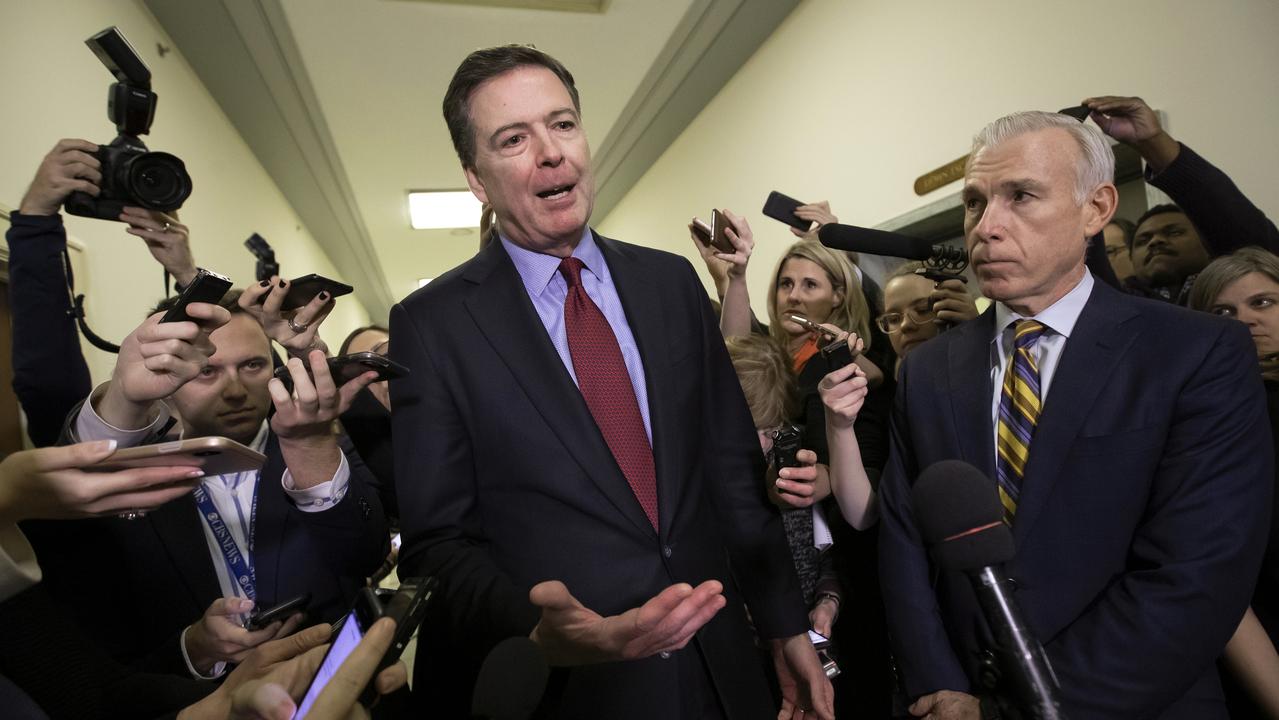Malcolm Turnbull risks all with NEG policy
Malcolm Turnbull is now engaged in a fast and furious reset to save his energy policy and his authority as PM in two critical domains.

Malcolm Turnbull is now engaged in a fast and furious reset to save his energy policy and his authority as Prime Minister in two critical domains — in the Coalition partyroom and in parliament.
Turnbull’s reset, to be unveiled early next week, is pivotal to keeping alive his energy policy but this is a moment of high danger for the Prime Minister because the changes are significant — he is bowing to his internal critics but conceding that without radical changes, his position could be threatened.
While decisions were still fluid last night after a day of policy rewriting, the two spearhead changes are, in the words of a senior figure, “taking a big stick to the energy companies” to secure guaranteed price reductions and a policy reversal to have the 26 per cent emissions reduction target set by ministerial determination, not legislation.
Turnbull and Treasurer Scott Morrison are closely collaborating on the reset along with Energy Minister Josh Frydenberg. The policy saviour on whom they rely is ACCC chairman Rod Sims and the demons in this project are energy companies AGL, Energy Australia and Origin, about to face a new and more punitive regime.
Turnbull’s leadership is not in play. He has the overwhelming backing of his cabinet. But conservative MPs are shaking the cage and promoting Peter Dutton as an alternative candidate. The NEG has become the vehicle that has crystallised a series of alarms about Turnbull, and his management of this issue next week and in coming weeks will be decisive.
The test of success depends on having some dissident MPs openly declare a change of heart and willingness to vote for the new stance. Turnbull never expected to win Tony Abbott’s backing but Abbott last night attacked the reset in comments to this newspaper. The reset involves an assessment that the present proposal — the national energy guarantee — does not achieve enough on the price front. This was the primary concern of Coalition MPs and was the underlying message from the partyroom debate on Tuesday. Turnbull has told protesting MPs that he will act.
A tougher stand on prices will be at the heart of the reset he hopes to announce on Monday after cabinet approval and ahead of the partyroom meeting on Tuesday. But the government will go further — it will seek punitive powers against the energy companies that go to divestment if corporate decisions mean higher consumer prices.
Turnbull has been personally devising the new emissions reduction model. Identifying the 26 per cent target by ministerial determination, not legislation, will be linked with a proposal that any rise must involve the regulator and the ACCC — they will need to publish the price consequences of any higher emissions target.
In short, a new government will have the power to lift the target and display superior climate change credentials — but it would need to tell the public how much prices would rise as a consequence. It would therefore be easier for a Shorten government to lift the emissions reduction target to Labor’s 45 per cent policy provided it was ready to live with the electoral impact of documented higher power bills. These changes are designed to satisfy two groups: those Liberal MPs who oppose in principle legislating the target and the Labor Party, whose core problem with the proposed national legislation was putting into law what it considered was an unacceptably low target. Given Shorten’s Labor argues more renewables will lower power prices — contrary to the lived experience — it should not be afraid of Turnbull’s new price disclosure mechanism.
A more radical position on emissions policy — abandoning the emissions reduction wing of the NEG along with the 26 per cent target — was canvassed in some discussions. This would constitute a victory for Abbott and the conservative rebels. However, it would be impossible for Turnbull to embrace such a reversal and retain his credibility.
The political aspirations of the reset are obvious: to minimise partyroom resistance, remove the main reason for any Labor opposition in the national parliament and encourage the reluctant Labor states to agree to the state-based legislation that establishes the framework of the NEG.
This is critical since Turnbull cannot secure the NEG through the federal parliament without Labor Party votes, given the lack of support from the Senate crossbench. As Morrison said this week: “We should have Labor’s support. That’s the point.”
The government will act on the ACCC recommendation for a new default price mechanism to check energy price escalation. It will authorise new measures to stop energy companies gaming the system. It will check the ability of energy companies to exploit vertical integration in the industry and set inflated prices. Government and party sentiment is about to turn savagely against the energy companies.

Given the current mood of irrationality and volatility inside the Coalition parties, the reaction to the reset defies prediction. But there is likely to be a conservative flashpoint — the idea of Coalition and Labor MPs sitting on the same side of the chamber voting the NEG.
Some conservatives told Inquirer yesterday the government would never recover from such a perception — and that some floor-crossing was guaranteed. Yet one of the high purposes of the policy reset is to ensure the NEG passes in parliament, and this involves support from Labor. It raises, therefore, the pivotal, paradoxical and unpredictable question: is the NEG Turnbull’s success or a path to more troubles?
The truth is vast policy differences remain between the main parties given Turnbull’s 26 per cent emissions reduction target and Shorten’s 45 per cent target. Regardless of what happens with the NEG, the next election will see a dominating choice for the nation between radically difference emissions reduction targets. Turnbull’s election game plan is to depict Labor as the party of higher taxes and higher energy prices. Turnbull’s task next week is to settle the party or at least curb the public dissension. This will not be easy given the anger and alienation in the party base. Conservative MPs are agitated about a range of problems — failing to put Bill Shorten under pressure, Catholic school funding, the stance on climate change and their belief the party’s social values are no longer championed.
Turnbull’s tactic is to split the rebel MPs by offering new interventions to lower energy prices — thereby winning over some dissidents who threaten to cross the floor while recognising that Abbott is not for turning.
How will the party react to the reset? It might be welcomed as a pragmatic response to an internal revolt; it might be seen as weakness under pressure; or it might be depicted as a desperate Turnbull trying to beat off any challenge to his leadership.
The real dilemma facing the Turnbull government is that its effort to finalise an energy policy and turn power price rises against Labor is being fatally ruined by its internal divisions over policy, ideology and leadership.
The great fantasy is that this dilemma can be resolved as was the 2009 crisis — by a dramatic change of leadership and a complete policy reversal under another leader. In that situation it was Abbott. There will be no repeat in 2018 of the clear-cut double-barrel “leadership and policy” revolution of 2009. This is the first and primary point to grasp about the internal politics.
The second point to grasp is that Turnbull is changing course under pressure and moving towards a brand of smart policy and clever populism. The risk, however, is that the Coalition will remain divided all the way to the next election. That means no permanent political truce. In this situation Turnbull’s hopes of turning energy policy against Labor will be undermined from within.
This week some of the populist pro-coal, anti-Turnbull conservatives embraced the proposition of “burn the village in order to save it”. Having convinced themselves that Turnbull faces certain defeat and that his energy policy is too compromised, they felt justified in engaging in an open and destructive revolt.

The reality is that the cabinet has backed the NEG without dissent. It can be expected to endorse the reset next week. It is now imperative for Turnbull and the fate of the government that some of the dissidents go public and welcome the reset. This is now a critical point.
The Liberals have a choice — more internal rupture or a return to some form of stability. A feature this week has been the influential anti-Turnbull media putting huge pressure on Liberal MPs to press the leadership button for Dutton. The Dutton option, at present, would fail on the numbers if attempted.
The Labor Party will be left with agonising choices about the NEG. Does it pass the NEG in the national interest to create a bipartisan energy policy framework? Or does Labor put politics first, vote down the NEG, wreak havoc on the Coalition side and drive the Turnbull government to the brink of doom?
There are two wars under way over climate change and energy politics. The first is between the Turnbull majority and the populist conservative rebels. The second is between the Labor Party and the Greens — the Greens brand the NEG as “death for renewables”, demand that Labor kill the NEG in parliament, demand the Victorian government kill the NEG by rejecting the state-based legislation, escalate their anti-coal crusade and seek emission cuts in the power sector by 90 per cent compared with Turnbull’s 26 per cent and Shorten’s 45 per cent.
The bottom-line certainty is that any internal failure or ongoing disunity within the Coalition will result in a huge win for the pro-Green Left and the exact opposite of what is sought by the Coalition conservatives — higher emissions reduction targets, higher renewable energy targets and more hostility towards coal and fossil fuels.
The latest energy eruption within the Coalition reveals the implosion of centre-right politics, an epic event for the country with potential to cripple the Coalition side for many years. The Turnbull-Abbott conflict goes to the soul of the Liberal Party. The Right has fragmented with One Nation sitting on 7-9 per cent of the primary vote and every Liberal base — parliamentary party, rank and file, ordinary voters and the right-wing media — torn apart over what should be the party’s true path.
The irony is that in recent times Newspoll shows a more competitive contest with four successive polls recording a reduced Labor lead at 51-49 per cent and Labor exposed on a range of policy fronts. Much of the present conflict is not just about the coming 2019 election but who will control and articulate the path for the Liberal Party after an election defeat.
Abbott’s thinking is geared heavily to post-election; he sees no prospect of any return to the leadership before the election and does not believe the party will remove Turnbull for anyone else. Turnbull utterly discounts that Dutton will resign and challenge. Any notion that a leadership challenge is the answer for the Liberals merely exposes the extent of delusion.
The extraordinary irony of the week is that Turnbull and Frydenberg scored a critical partyroom victory on Tuesday for their energy policy but saw victory turn into chaos. Such is the condition of this Coalition government.




To join the conversation, please log in. Don't have an account? Register
Join the conversation, you are commenting as Logout